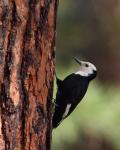The White-headed Woodpecker (Dryobates albolarvatus) is a primary excavator that occurs in pine- (Pinus spp.) dominated habitats throughout its geographic distribution. Throughout the interior Pacific Northwest, the White-headed Woodpecker is historically associated with large-diameter ponderosa pine (Pinus ponderosa) forests. Historically these pine forests were maintained by frequent fires that occurred every 5–15 years. Old trees (>150 years) in these historic forests were 40–91 cm dbh and ranged in density from 19 to 49 per hectare. Effective fire exclusion, as well as a long period of selective logging of large trees, has dramatically changed the structure and species composition of modern-day ponderosa pine forests. Today, ponderosa pine forests have 3–10 times the density of trees compared to historic conditions, with the majority of trees being 20–30 cm dbh. Old forests dominated by widely spaced, large ponderosa pine are now a minor or missing landscape component, and many dry forest landscapes contain few or no old forest structures. Determining the composition of modern-day ponderosa pine forests occupied by White-headed Woodpeckers will aid our understanding of the habitat used by this species and may inform projects designed to restore ponderosa pine forests.
This study evaluates tree characteristics, tree species composition, and overall structure of dry forests used by Whtie-headed Woodpeckers for nesting. Specifically, my objectives were to determine (1) the overall density of trees and snags, and basal area for sites occupied by nesting White-headed Woodpeckers; (2) the density of trees and snags by dbh class, with emphasis on the density of large-diameter trees (>50.8 cm dbh); and (3) the species composition and importance value for each tree species.
Determine the characteristics of ponderosa pine stands with a history of timber management that also support nesting White-headed Woodpeckers.
This project was completed in 2009 and the results were published in the peer-reviewed journal The Western North American Naturalist in 2011. The .pdf of this published paper can be accessed by clicking on the link below.
Status: Completed
04/01/2005 to 09/01/2009Project Manager
-
Jeff Kozma ,
Timber, Fish and Wildlife (TFW), Wildlife Biologist
509-865-5121 x6343

